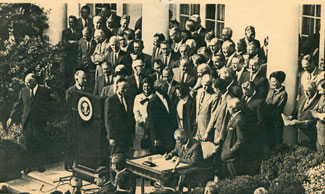The National Endowment for the Arts turned 45 the other day: President Lyndon Johnson signed the law creating the agency on Sept. 29, 1965. And to note the day, the NEA put out a list of statistics — which got little notice. I thought I’d share some of the most interesting ones.
- Total dollar amount of NEA grants awarded to nonprofit organizations: $4 billion in more than 130,000 grants.
- Average ratio of matching funds to NEA awards: 7:1.
- Languages translated into English through NEA Literature Translation Fellowships: 61
- Most recent estimate of languages spoken worldwide: 6,909
- Most common full-time arts profession: graphic designer
- Most common volunteer performing arts activity: choral singer
- Rank of education as a primary influence on arts participation: #1
- Average time Americans age 15-24 spent watching TV daily: 2 hours
- Average time spent reading for pleasure daily: 7 minutes
- Percentage of American recipients of the National Book Awards, National Book Critics Circle Awards, and Pulitzer Prizes in fiction and poetry who have received NEA Creative Writing Fellowships: 58
 Here’s a link to the press release.
Here’s a link to the press release.
Now, the National Endowment for the Humanities was created by the same act of Congress, signed into law by LBJ, a fact the NEA neglected to mention in its release (except that Humanities was part of the act’s name).
But over at the Humanities site, things were different. The NEH celebrated by going the historical route — no numbers, just a short summary relating what happened the day LBJ created both endowments in the White House Rose Garden, surrounded by scholars, artists and other luminaries. LBJ said:
We in America have not always been kind to the artists and the scholars who are the creators and the keepers of our vision. Somehow, the scientists always seem to get the penthouse, while the arts and the humanities get the basement.
A gala reception was held that night at what is now the Smithsonian’s National Museum of American History (which I reviewed here in 2009). There, Vice President Hubert Humphrey said that the two new agencies represented “the true meaning of the Great Society” and likened it to the Marshall Plan (see more here).
Well, not exactly.
Photo Credit: Courtesy of the NEH
